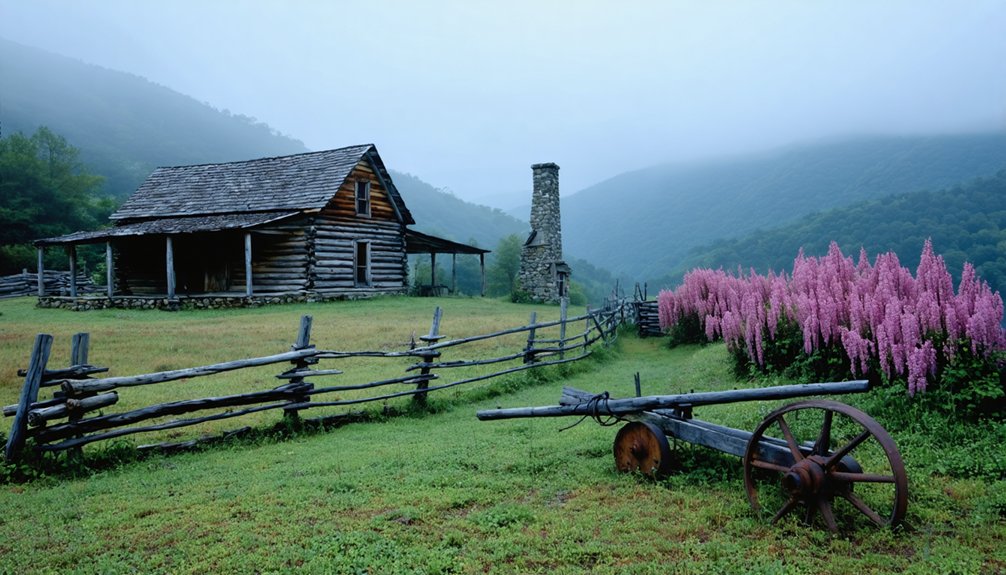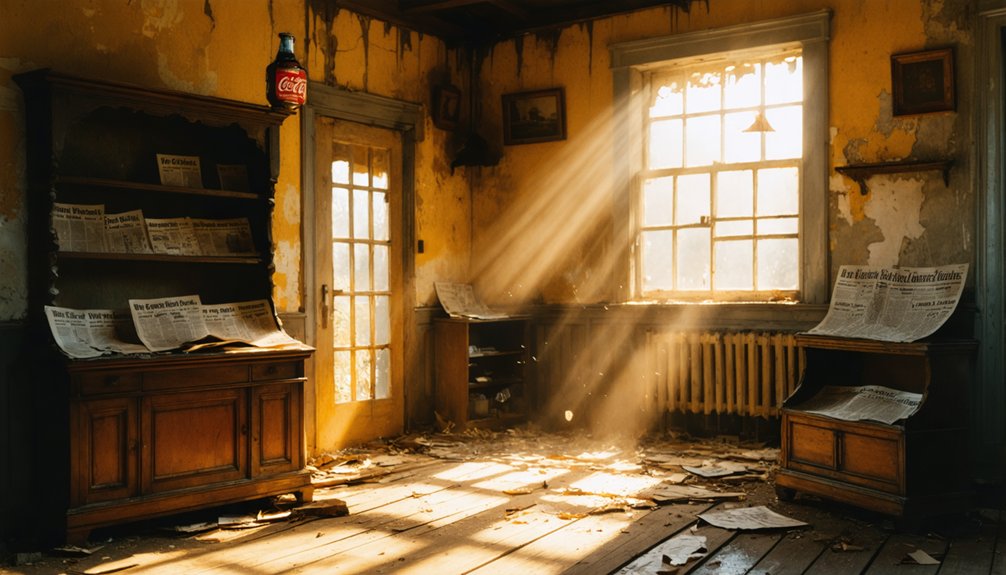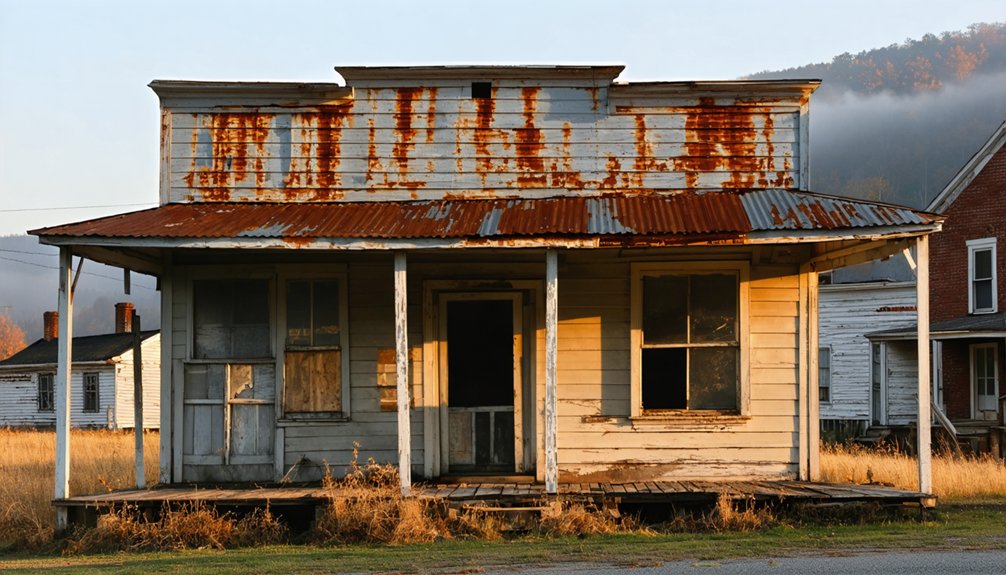You’ll discover Hensley Settlement perched atop Kentucky’s Brush Mountain, where pioneering families established a self-sufficient community in the early 1900s. The settlement thrived without electricity or modern conveniences, as residents lived off the land through traditional farming and crafts. Though the last resident departed in 1951, twelve restored log cabins and a blacksmith shop remain as reminders of mountain life. This preserved ghost town holds countless stories of Appalachian resilience and ingenuity.
Key Takeaways
- Hensley Settlement was established in 1903 atop Brush Mountain in Kentucky, thriving as a self-sufficient community of about 100 residents.
- The settlement operated without modern amenities, using kerosene lamps, wood stoves, and traditional methods for daily living.
- By 1951, the settlement became abandoned after World War II and coal mining drew residents away from their mountain community.
- Sherman Hensley was the last resident to leave, marking the settlement’s complete transformation into a ghost town.
- Now preserved by the National Park Service, twelve restored log cabins showcase early 20th-century Appalachian mountain life.
A Mountain Community’s Birth and Early Years
While many Appalachian settlements emerged in the 19th century, Hensley Settlement‘s story began in 1845 when Governor William Owsley deeded 500 acres to the Bales brothers.
The community’s true establishment wouldn’t take shape until 1903, when Burton Hensley Sr. purchased 2,000 acres of mountain land, sharing portions with his children.
The early settlers, led by Sherman Hensley and his family, carved out their independence atop Brush Mountain.
You’ll find that these pioneering families, primarily of English and Scotch-Irish descent, built sturdy chestnut log cabins with shake roofs. Today, visitors can explore twelve restored cabins that stand as testament to their craftsmanship.
The Hensley and Gibbons families formed the backbone of this close-knit mountain society, creating a self-reliant community far removed from the modernizing world below. Their determination to maintain independence was evident in their lifestyle, as they relied on their one-room schoolhouse built in 1908 to educate their children.
Life Without Modern Conveniences
Despite having no electricity, indoor plumbing, or modern amenities, the residents of Hensley Settlement mastered the art of self-sufficient living through ingenuity and determination.
You’d find kerosene lamps and candles illuminating their modest cabins, while wood-burning stoves and hearths provided essential heat and cooking capabilities. Their sustainable living practices centered on manual labor, from hauling water from springs to gathering firewood for daily needs.
The settlement’s residents developed a remarkable system of self-reliance. The community relied heavily on their local gristmills to process grains for daily sustenance.
You’d see spring houses used for natural refrigeration, while smoke houses preserved their meats. They’d craft their own soap, make candles, and maintain their tools at the community blacksmith shop.
This lifestyle, though demanding, gave them independence from the outside world’s growing dependence on modern conveniences.
Family Ties and Mountain Traditions
When Burton Hensley Sr. acquired 200 acres atop Brush Mountain in 1903, he laid the foundation for a tightly-knit community bound by blood and marriage. Family bonds between the Hensleys and Gibbonses formed the settlement’s backbone, with about 100 residents working together to create a self-sustaining mountain society.
You’ll find their cultural heritage woven through every aspect of daily life. Willie Gibbons served as the community blacksmith and carpenter, while other family members maintained traditional roles in farming, animal husbandry, and domestic crafts.
Together, they preserved Appalachian traditions through communal activities like sheep shearing, hog butchering, and seasonal farming. Children learned these time-honored practices while attending the local school, ensuring their mountain ways would endure through generations.
The Last Resident’s Departure
As World War II drew young men away from Brush Mountain for military service and coal mining jobs, Hensley Settlement began its slow descent toward abandonment.
You’ll find the community’s last days marked by a steady exodus, as families sought modern conveniences and opportunities in the valleys below. The settlement’s isolation, without roads or electricity, made daily life increasingly challenging as surrounding areas modernized.
The mountain lifestyle had long depended on mud chinked log houses that sheltered generations of residents through harsh winters and hot summers. The site would later be preserved as a living history museum, allowing visitors to explore the mountain’s rich past.
Community memories center on Sherman Hensley, who’d established his homestead in 1903 with his wife Nicey.
Sherman and Nicey Hensley planted roots atop Brush Mountain in 1903, becoming central figures in their isolated mountain community.
After watching neighbors depart and the old generation pass away through the 1940s, Sherman remained as the final resident until 1951. His departure closed nearly half a century of mountain life, transforming the settlement from a living community into a preserved piece of Appalachian heritage.
Preserving an Appalachian Time Capsule
Since its abandonment in 1951, Hensley Settlement has transformed into a remarkable time capsule of early 20th-century Appalachian life through careful preservation by the National Park Service.
You’ll find twelve meticulously restored log cabins, a one-room schoolhouse, and a blacksmith shop that showcase the settlement’s historical significance through authentic building techniques and materials.
The cultural preservation efforts here are extensive, requiring specialized conservation methods due to the site’s remote location and lack of modern infrastructure.
You’re able to experience this rare intact mountain homestead through guided tours that reveal the self-sufficient lifestyle of these independent settlers.
The site’s artifacts, tools, and oral histories provide invaluable insights into traditional Appalachian culture, while ongoing maintenance guarantees this irreplaceable piece of American heritage endures for future generations.
Frequently Asked Questions
Were There Any Recorded Crimes or Law Enforcement Issues in Hensley Settlement?
You won’t find documented crime history or law enforcement issues there – no police reports, court records, or criminal cases exist. The settlement’s isolation and self-governing nature kept formal authorities away.
How Did Residents Handle Medical Emergencies Without Modern Healthcare Facilities Nearby?
You’d rely heavily on home remedies and local healers within your community, treating injuries and illnesses with herbal medicines, while neighbors helped transport critical cases to distant medical facilities.
What Happened to the Original Furnishings and Belongings After Abandonment?
You’ll find many abandoned treasures stayed right where residents left them in 1951, while others deteriorated naturally. Some historical artifacts were preserved during 1960s restoration efforts or collected by descendants.
Did Any Supernatural or Ghostly Encounters Get Reported at Hensley Settlement?
You won’t find documented ghost sightings or paranormal investigations at this location. Historical records and official sources show no supernatural encounters, focusing instead on the settlement’s authentic cultural heritage and daily life.
Were There Any Documented Conflicts Between Hensley Settlement and Neighboring Communities?
You won’t find documented conflicts between this mountain settlement and its neighbors. The community’s isolation, family-based structure, and self-sufficient lifestyle kept conflict history minimal and community relations largely nonexistent.
References
- https://appalachianmountaindreams.com/2023/06/19/hensley-settlement-miracle-ky-kentucky-life-ket/
- https://www.townofcumberlandgap.com/hensley-settlement/
- https://www.nps.gov/cuga/learn/historyculture/hensley-settlement.htm
- https://npshistory.com/publications/cuga/hensley-settlement-history.pdf
- https://npshistory.com/publications/cuga/nr-hensley-settlement.pdf
- https://www.pbslearningmedia.org/resource/earam.arts.drama.hensley/early-america-hensley-settlement/
- https://en.wikipedia.org/wiki/Hensley_Settlement
- https://www.nps.gov/parkhistory/online_books/cuga/cuga_hensley_settlement.pdf
- http://www.outpostusa.org/Hensley Settlement.html
- https://digitalcommons.wku.edu/theses/2670/



